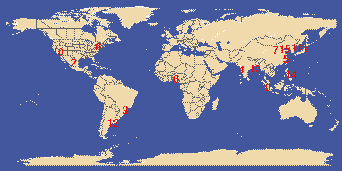- "Our coasts are reaching a crisis. Threats to coasts and to coastal communities are growing as development, recreation, and waste disposal activities increase, often in conflict with long-term natural processes. Other threats to our coasts, such as sea-level rise and reduction in sediment supply, result from global warming and the damming of rivers.
The impending crisis of our coasts stems from misconceptions about what coasts are-and from actions based on those misconceptions. Differences between our perceptions and the reality of coasts intensify the conflicts between people and nature. These conflicts will worsen as the coastal population expands and competing uses of the recreational, wildlife, shipping, and mineral resources of coasts increase." (United States Geological Survey).
Locate the Gulf of Mexico south of Houston, Texas on this map of Annual Shoreline Change. Are you familiar with the kinds of changes taking place and some of the probable causes?

- "Already, more than half the world's population-- over 2.7 billion people--live within 60
miles (100 km) of a coastline. Rapid urbanization, especially in developing countries, will lead to more coastal megacities--cities with 10 million or more people. As coastal zones become more densely populated, coastal water quality will suffer, wildlife will be displaced, and shorelines will erode. Thirteen of the fifteen largest cities will lie on or near coasts" -- the exceptions are Mexico City and Beijing.(Growing Pains)
- "More than one-half the population of the United States now lives and works within 50 miles of the coastline, but coastal areas account for only 11 percent of the nation's land area. In recent years, 40 percent of new commercial development and 46 percent of new residential development happened near the coast. Natural hazards, such as storms, along the coast can turn into natural disasters if people ignore the dangers or aren't prepared." (Ocean Facts)
- Washington, June 27, 2000 --Approximately 25 percent of homes and other structures within 500 feet of the U.S. coastline and the shorelines of the Great Lakes will fall victim to the effects of erosion within the next 60 years, according to a study released today by the Federal Emergency Management Agency (FEMA). The study was prepared for FEMA by The HeinzCenter for Science, Economics and the Environment.
"This report, Evaluation of Erosion Hazards, provides for the first time a comprehensive assessment of coastal erosion and its impact on people and property along our nation's ocean and Great Lakes shorelines," FEMA Director James Lee Witt said. "The findings are sobering. If coastal development continues unabated and if sea levels rise as some scientists are predicting, the impact will be even worse."
Especially hard hit will be areas along the Atlantic and Gulf of Mexico coastlines, which are expected to account for 60 percent of nationwide losses. Costs to U.S. homeowners will average more than a half billion dollars per year, and additional development in high erosion areas will lead to higher losses, according to the report. Highly protected areas of large East Coast cities will not be adversely affected.